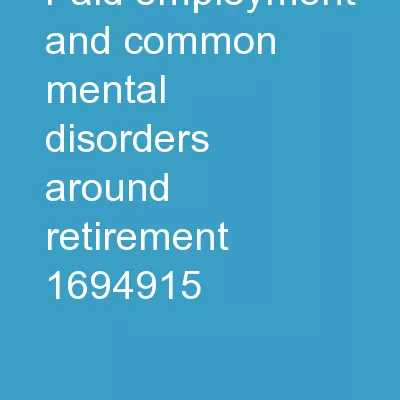

Gayan Perera Robert Stewart Kings College London IoPPN WHERL is an interdisciplinary consortium funded by the crossresearch council Lifelong Health and Wellbeing LLHW programme under Extending Working Lives ESL0028251 ID: 758384
Download Presentation The PPT/PDF document "Paid employment and common mental disord..." is the property of its rightful owner. Permission is granted to download and print the materials on this web site for personal, non-commercial use only, and to display it on your personal computer provided you do not modify the materials and that you retain all copyright notices contained in the materials. By downloading content from our website, you accept the terms of this agreement.
Slide1
Paid employment and common mental disorders around retirement
Gayan PereraRobert StewartKing’s College London (IoPPN)
WHERL is an interdisciplinary consortium funded by the cross-research council Lifelong Health and Wellbeing (LLHW) programme under Extending Working Lives (ES/L002825/1)Slide2
Background
Employment trend by age in UK
E
mployment and mental health
Well-recognised association between
unemployment
and worse mental health (e.g. meta-analysis, Paul et al., 2009).
Mental health and employment status around retirement has not been adequately described (particularly longitudinal trajectories).
ONS. Labour Force SurveySlide3
N
umber of people of state pension age (SPA) and above who remain in work almost doubled
between 1993-2011 (now 1.4m; ONS, 2012)
Proportion
of people remaining in the workforce after SPA has also increased (7.6% in 1993 to 12.0%
in 2011; ONS, 2012)Employment
in older populationsSlide4
Effect of paid
work on health and well-being in later life
Some studies suggest paid employment
after SPA is
beneficial for health and well-being (Adam et al., 2007; Rohwedder
and Willis, 2010; Behnke, 2012; Bonsang et al., 2012; Calvo et al., 2013)
Some suggest that it is detrimental (Coe and Zamarro, 2011) and some that there is no significant or meaningful relationship
(Coe and Lindeboom, 2008; Coe and Zamarro, 2011; Behnke, 2012; Calvo et al., 2013).Slide5
British Adult Psychiatric Morbidity Surveys, a cross-sectional survey in nationally representative samples.
Three surveys to date: 1993, 2000, 2007 (2014 survey complete but data not yet available).
Focus for these analyses:
50-64 year olds living in England (1993, 2000, 2007)
65-74 year olds living in England (2000, 2007)
Data
Slide6
Paid employment and common mental disorders in 50-64 year olds: analysis of 14 years of national data (1993-2007
)
Gayan Perera
1
, Karen Glaser
1
,
Rob Stewart1, et al
1
King’s
College
London
WHERL is an interdisciplinary consortium funded by the cross-research council Lifelong Health and Wellbeing (LLHW) programme under Extending Working Lives (ES/L002825/1)Slide7
Prevalences of Common Mental Disorders (CMD) in 50-64 year oldsSlide8
CMD by employment statusSlide9
* Adjusted for
age,
marital status, highest qualification, social class, tenure, serious debt, smoking status
Association* between non-employment and CMDSlide10
Association*
between non-employment and CMD
* Adjusted for
age,
marital status, highest qualification, social class, tenure, serious debt, smoking
status. Reference group is those in paid employment.Slide11
* Adjusted for
age,
marital status, highest qualification, social class, tenure, serious debt, smoking status. Reference group is those in paid employment.
Association*
between
non-employment and CMDSlide12
Paid employment and common mental disorder in 65- 74
year olds: analysis of 7
years of national data
(2000-2007)
Gayan Perera
1
, Karen Glaser1
, Rob Stewart
1
et al
1
King’s
College
London
WHERL is an interdisciplinary consortium funded by the cross-research council Lifelong Health and Wellbeing (LLHW) programme under Extending Working Lives (ES/L002825/1)Slide13
CMD by employment status:
65-74 year oldsSlide14
Association between non-employment and
CMD in 65-74 year olds
* Adjusted for
age,
marital status, highest qualification, social class, tenure, serious debt, smoking
status
. Reference group is those in paid employment.Slide15
Summary
More people in work in 50-74 year age groups(Modest) increase in CMD prevalence over time
People in work are healthier (before and after age 65)
Non-employment prior to 65 only associated with CMD if due to health reasons (but independent of current physical health)
No consistent time-trends (apart from men in 2000)
Similar for men and women (apart from 2000)Non-employment after 65 associated with CMDBut only independently in 2007Slide16
www.wherl.ac.uk
Questions